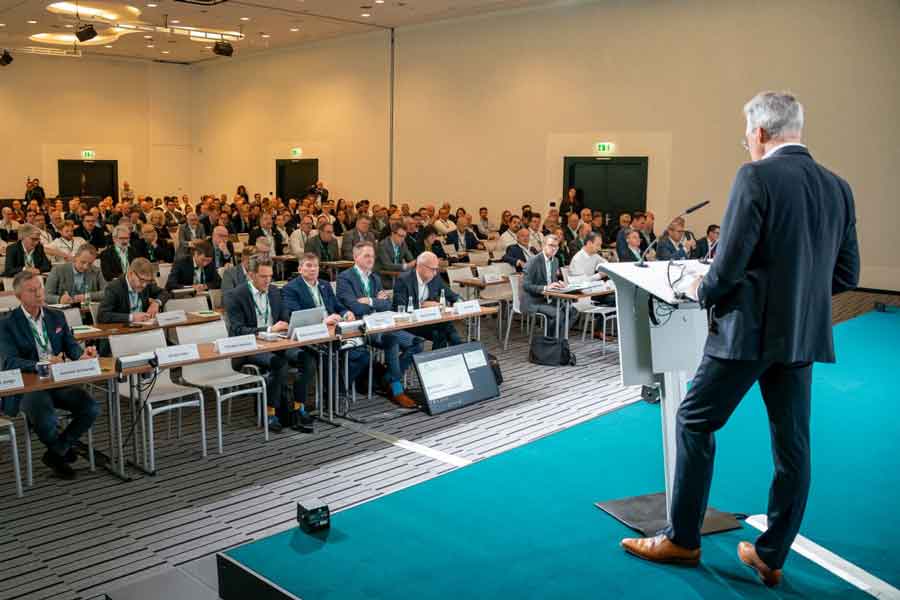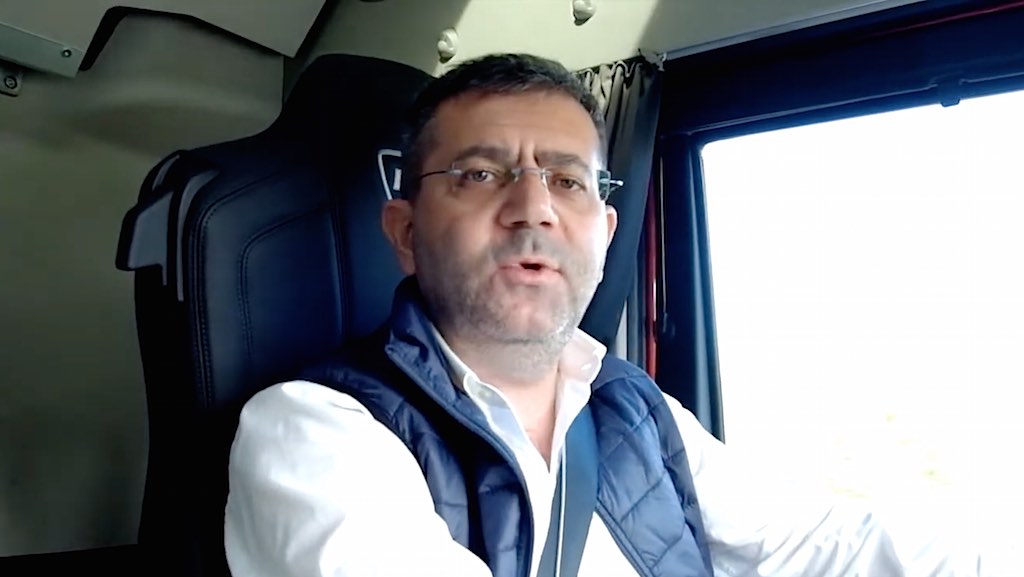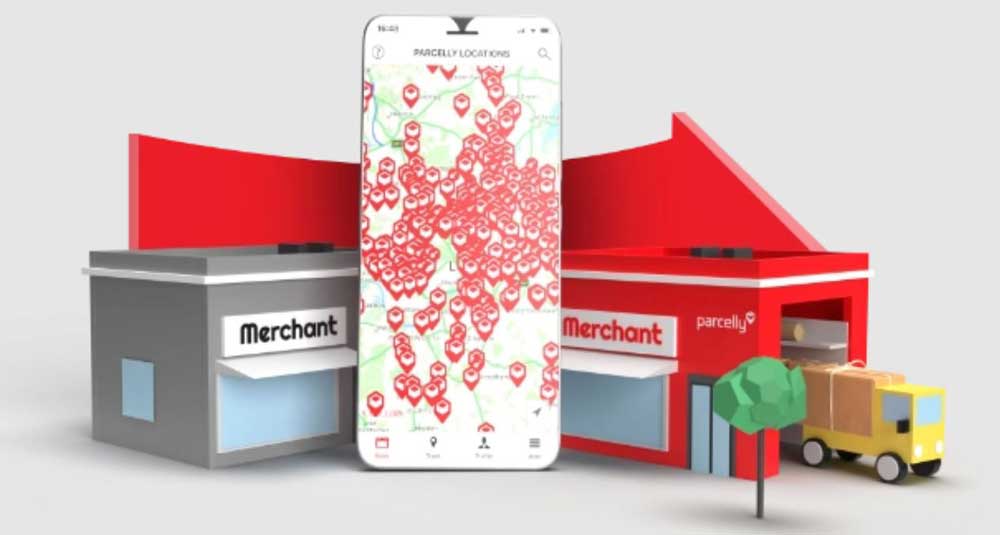At the 5th DEKRA Commercial Vehicle Outlook Conference on October 30 and 31 in Berlin, experts and practitioners from politics, industry, research and the transport sector discussed the potential of innovative technologies related to the commercial vehicle of tomorrow. The presentations and panel discussions focused on topics such as automated driving as a contribution to reducing the number of crash victims, the potential of alternative drives for climate protection in freight transport, digital solutions for everyday logistics and load securing, strategies and concepts for more sustainability on the last mile, cyber security in the office and in the vehicle, or artificial intelligence in the sector.
Whether it is the long-term traffic forecast of the Federal Ministry for Digital and Transport for Germany or the Transport Outlook of the International Transport Forum with a global focus, to name just two examples: Freight traffic on the roads will keep increasing significantly by the year 2050. This means numerous challenges for commercial vehicle manufacturers and their suppliers, for the entire transport and logistics industry, as well as for politics and science. And this in terms of efficiency and environmental compatibility as well as in terms of road safety.
These challenges were discussed in detail at the DEKRA Future Congress with around 350 participants in the three parallel thematic strands of commercial vehicle technology, digitalization, and last mile. “Future-proof freight transport remains essential for our economies and for society as a whole”, said Jann Fehlauer, Managing Director of DEKRA Automobil GmbH, at the opening. Once again, the event underlined its position as a central platform for the entire transport and logistics industry. Held for the first time in this form in 2015, the congress has evolved from traditional event series organized by DEKRA and ETM publishing house. It bundles all the topics that move the various interest groups and stakeholders around the commercial vehicle. “In view of the transformation of road haulage, it is of central importance right now that all those involved jointly set the decisive course correctly”, emphasized Jann Fehlauer.
Politics and industry need to intensify their exchange
A central focus at the congress was the question of what requirements transport and logistics companies will have to meet when they switch to alternative drive systems. In this context, Hartmut Höppner, State Secretary at the German Federal Ministry for Digital and Transport, reminded the audience in his keynote speech of the German government’s climate protection law. According to this law, greenhouse gas emissions must be reduced by 65 percent by 2030 compared to 1990. A reduction target of at least 88 percent applies for 2040, and Germany is to achieve climate neutrality by 2045. “The transformation can only succeed in a joint effort between politics and business”, Höppner said. At the same time, he said, the switch to climate-friendly solutions also offers opportunities for the transport industry and is associated with competitive advantages. It is important to actively shape the change now, he said. “Doing nothing will not solve any problems”, the State Secretary pointed out.
Martin Schmied, Head of Environmental Planning and Sustainability Strategies at the German Federal Environment Agency, showed that there is still a long way to go before we achieve climate neutrality. Above all, he pointed out that the climate protection measures currently adopted by politicians in the field of alternative drive systems in road freight transport, such as vehicle subsidies, infrastructure development and regulatory measures in the form of the CO2 toll, for example, will not enable the declared emissions targets to be achieved. “According to the German government’s projection report, a gap of 28 million tons of CO2 equivalents can be assumed for the year 2030 alone”, Schmied elaborated. Climate protection is more than ever a task for society as a whole, he said, and the targets can only be achieved with a combination of energy turnaround and transport turnaround.
The environment and transport expert provided initial insights into an unpublished study by his institution, in which the environmental balance of alternative drive systems is compared with that of conventional fuels. One result: “E-mobility already has a clear climate advantage over vehicles with combustion engines, even for trucks, and this will increase in the future.”
Technology openness without trench warfare
For his part, Thomas Fabian, commercial vehicle director of the European vehicle manufacturers’ association ACEA, made it clear: “The manufacturers have done their homework, and the vehicles needed for the changeover are ready.” He added that policymakers must now focus on decarbonization instead of running the risk of losing focus on this due to new regulatory requirements such as the Euro 7 emissions standard. There is also an urgent need for a much faster development of a comprehensive Europe-wide charging infrastructure. With this, he spoke from the heart of the representatives of well-known vehicle manufacturers present – including Joachim Schlereth, Head of Sales and Services Truck Mercedes-Benz and Fuso Germany, who presented the battery-electric long-distance truck eActros 600 from Mercedes-Benz Trucks.
For Frank Huster, Managing Director at German Federal Association of Transport and Logistics DSLV, e-mobility has arrived in road freight transport. In the end, however, the vehicle purchases must pay off for the entrepreneur over the total operating time. Predictions about the development of electricity prices are impossible.
Battery-electric solutions, this was made clear at the DEKRA Future Congress Commercial Vehicles 2023, are of course only one of numerous variants on the road to decarbonization. As various presentations underlined, gas drives, alternative fuels and hydrogen drive must also be considered in view of the increasingly visible climate change.
In addition to the question of propulsion, various speakers also addressed the challenges and opportunities for suppliers arising from the electrification, automation, and digitalization of commercial vehicles for their own product portfolios. For example, Dr. Huba Németh, Director Advanced Engineering at brakes manufacturer Knorr-Bremse, explained the company’s modular approach to so-called fail-operational and safety-critical systems in fully automated driving. Other speakers from suppliers and trailer manufacturers such as SAF-Holland, Kögel, Schmitz Cargobull, Krone and BPW outlined the concepts they are using to meet the ongoing disruption.
Extensive testing of automated systems
The safety of commercial vehicles also received due attention at the congress. “Vehicle development has made great progress in this area in recent decades”, DEKRA Managing Director Jann Fehlauer emphasized. Driver assistance systems such as lane keeping systems or emergency brake assistants could save lives. The decisive factors are that they are as widespread as possible in the fleet, make full use of what is technically possible, cannot be manipulated and function permanently. Before approval and series production, the systems must therefore be thoroughly tested and evaluated. And this is precisely what happens at the DEKRA Technology Center in Klettwitz, Brandenburg, among other places, as Uwe Burckhardt, Head of Test and Event at the DEKRA Lausitzring, explained in his presentation.
In recent years, the expert organization has created Europe’s largest independent test site for automated and connected driving at the Lausitzring on a total area of around 550 hectares. The latest milestone was the inauguration of special city courses at the end of June 2023, where automated driving functions can be tested in an urban environment as realistically as possible. “With the help of state-of-the-art technology, we can place vehicles in situations of almost any complexity in order to subject their automated driving functions to the maximum test challenge”, Uwe Burckhardt went into detail. In so-called swarm tests, up to twelve moving objects can be used in the environment of the test vehicle. Such objects can represent a wide variety of other vehicles as well as pedestrians and can be controlled with centimeter precision. According to the DEKRA expert, this means that the same test sequences can be reproduced again and again so that systems and functions can be tested under the same conditions. For example, the reaction of an emergency brake assistant to the end of a traffic jam or a pedestrian suddenly crossing the road, the behavior of a turning assistant in the case of a cyclist in the blind spot, or even the reliability of highly and fully automated vehicle systems of the future.
Added value through intelligent telematics
At the 5th DEKRA Commercial Vehicle Outlook Conference, the experts and practitioners from industry and research also took a close look at the status and further developments in digitalization and the last mile. The focus was on questions such as: Which new services increase the efficiency of tachographs? How can artificial intelligence optimize route planning in commercial vehicle fleets? How can load securing be improved by digitizing individual processes? What about the refueling and charging infrastructure for the last mile? Finally, the topic of cyber security was omnipresent in Berlin. After all, the desired increase in efficiency can only really be achieved if the data is secure and protected against attacks while in transit. Here, too, the Outlook Conference presented promising solutions.










